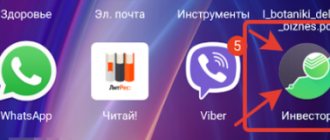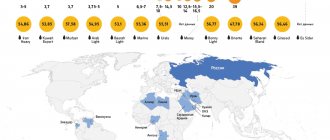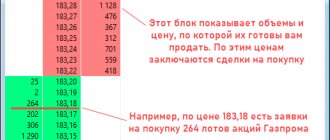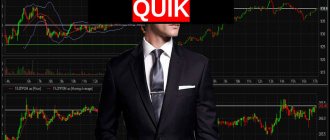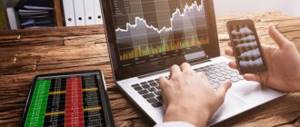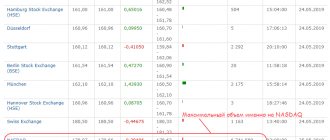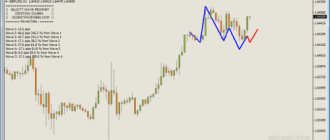MetaQuotes Software Corp. developed the Metatrader 4 trading terminal for organizing dealing services on international financial markets. It is through this platform that every trader can trade by opening accounts with most brokers.
The program was created back in 2005. It is independent, which is why most brokerage companies provide access to markets through this platform. The updated version of the program is Metatrader 5.
Before trading in MetaTrader 4, it is wise to familiarize yourself with the instructions and functionality of the system. After all, through the trading platform, Forex technical analysis, forecasting is carried out using built-in and external indicators and other tools.
]]>Where to download Metatrader?
You can now download a trading terminal on the website of almost every Forex broker. Usually versions 4 and 5 are available there, as well as a program for Android.
But is it really necessary for those who have several client accounts in different companies to load the terminals of each of them? If there is no need to keep all terminals open (for robots, trailing, and so on), then why install several terminals of different brokers when all metatraders4(5) are almost identical???
Sometimes it is enough to have one working terminal with registered servers for each broker. Therefore, you can download the original clean build of Metatrader from the official website https://www.metatrader4.com/ru/download]]> - it will be no different from other terminals.
Having the address of the trading server, account number and password, you can use one terminal to pull up all trading accounts in different DCs. This is how the server is registered in the terminal:
Select the menu “File” -> Open account. Next, in the field below, enter the server name and click on scan. If the server is found, it will then be marked with a green icon; if not, it will be marked with a red icon.
Thus, the server is already registered in your terminal. Next, you just need to enter your account number and password. You can view the servers of the most commonly used Forex brokers here.
World Forex
This broker is different in that for it currency pairs are an additional service, but binary assets are the main one. The company has been working with options since 2008; MetaTrader offers only one type: the classic “Higher/Lower”. The option premium reaches 100%, the return of loss in case of failure is no more than 14%; Early closure is possible with a 40% refund of the investment. In addition to options on major currencies, transactions on cross rates and spot metals are offered.
Eat:
- demo account;
- minimum deposit – $1;
- transaction amount – min $1 and max $300;
- European and American options, Profi options “0-100” with a fixed return of 100%;
- expiration – from 1 minute to 7 days, for Profi options – from 1 hour to 5 days;
- bonuses for replenishing a deposit from $100.
WebTrader and MT4 platforms are offered (mobile versions are available). Pending orders (options with a delay) and trading automation tools are allowed. Despite the information on the official website, in fact its activities are not regulated by any serious organizations.
]]>How to open a demo account in MetaTrader?
After launch, the program usually immediately offers to open a new demo account. It will be useful to do this. If this does not happen, then you can open a new demo account through the “File” -> “Open Account” menu. After selecting a server and the “New demo account” item, a registration form will appear. Fill its fields with arbitrary data, for example, as shown in the figure.
After completing registration, write down your terminal login information, you may need it.
If you can’t open a demo account through the terminal, then open it on the broker’s website. Recommended brokers : Alpari]]>, ]]>Instaforex]]>, ]]>Roboforex]]>
Then, when you receive your login and password, be sure to save them somewhere! Next, open the “File” menu -> “Connect to a trading account” and in the window that opens, enter your login, password and server.
The advisor is ready. Let's launch it!
We look carefully at the screenshot and launch the trading advisor.
- In the navigator (Ctrl+N) look for the Advisors tab. Expand it by clicking on the plus sign.
- Drag our advisor onto the chart.
- The advisor settings window pops up - click OK.
How do you know everything is working? On the top right, next to the indicator name, there will be a smiley face. We noted it in the example above.
Main terminal menu items
Let's consider the active work area of the terminal. It is divided into several elements, including standard ones:
- menu (1),
- toolbars (2),
- status line (7).
On the left are the “Market Watch” (3) and “Navigator” (4) windows, on the right is the main field for charts (6), where a trader can manipulate charts of various financial instruments (currency pairs). Each graph opens in a separate window, and these windows can be arranged in different ways: mosaic, cascade, with vertical or horizontal division, or expanded to the entire work area with tabs for switching between graphs.
Below is the terminal window (5), which displays all open transactions. If you switch bookmarks, you can find a lot more interesting things there: minutes, news, a broker message, a library of advisors, a catalog of signals, a reminder, but the most interesting thing for a beginner is the history of our transactions. All closed transactions and non-trading balance changes (deposits, withdrawals, accrual of agent fees, etc.) are displayed there.
How to customize the appearance of charts in the Metatrader 4 terminal?
The main thing to start getting acquainted with the terminal is to understand the charts well. After a new installation of the terminal, from the beginning there are already several open charts with various indicators attached to them. We recommend that you immediately close all these windows and open new, clean charts. To do this, you need to select a currency pair in the “Market Watch” window and right-click on it, select “Chart Window” in the context menu.
To easily analyze the price chart, you may need to customize it as much as possible to suit your needs. To change the appearance, you need to change the properties of the chart; to do this, you need to right-click on any empty area on the chart and select “Properties” in the context menu or simply press the F8 key. In the window that appears on the “Colors” tab, you can change the color of all elements of the graph, and on the “General” tab you can configure the basic options of the graph.
Details about each option.
- Offline chart - if checked, the chart becomes offline, new price data is received and its display stops.
- Chart on top—sets the display mode of chart candles in the foreground relative to other objects.
- Graph Offset - moves the graph from the right edge to the offset mark, which can be moved within 10-50% of the graph window.
- Auto-scrolling chart—sets the mode to automatically shift the chart to the left as new data arrives and display new candles.
- Fix scale—fixes the current chart scale; otherwise, when scrolling, it is scaled vertically automatically.
- Fix scale 1:1—fixes the scale in such a way that the size of one point in the vertical axis in pixels is equal to the distance between the axes of adjacent bars.
- Bars—sets the chart display mode as bars.
- Japanese candlesticks—sets the chart display mode in the form of Japanese candlesticks.
- Line—sets the chart display mode as a line connecting closing prices.
- Show OHLC - shows on the left next to the symbol and timeframe of the current bar's price (open, high, low and close).
- Show Ask line - along with the Bid price line, it also displays the Ask price line.
- Show period separators - places additional vertical lines on the chart, corresponding to the boundaries of bars from a larger time frame; for charts M1 to H1, the separators correspond to daily bars, for H4 charts - weekly, for D1 - monthly, and for W1 and MN1 - summer.
- Show grid—displays a grid on the chart.
- Show volumes—displays bars at the bottom of the chart that correspond to the pseudo-volume of each bar; it does not work with a fixed scale.
In the MT4 terminal, until recently, information about real market volumes was generally unpredictable technically; instead, the number of so-called ticks is now displayed - pieces of information on price changes received from the server for a certain period.
Some of these options can be configured globally for the entire terminal through the Tools -> Settings menu, as well as in some other menu locations. “Chart offset”, “Auto-scroll” and the choice of chart display mode (Bars, Candlesticks and Line) can also be quickly switched from the toolbar. Also on the toolbar you can increase or decrease the scale of the chart (size of one bar), as well as select a time scale, the so-called timeframe: M1, M5, M15, M30, H1, H4, D1, W1, MN1.
After setting up one chart, in order not to repeat all these steps with each chart separately, you can save the settings as a template. Then, when you open new charts, you can apply previously created templates to them. And if you name the template 'default.tpl', then this template will be automatically applied to all new charts.
Thus, we have become familiar with the main elements of the trading terminal interface and the most important settings for currency pair charts. Don’t forget that any answers to your questions related to the operation of the terminal can be found in its user manual, which can be called up by pressing the F1 key.
Timeframe - what is it?
A time frame is the time period reflected on the chart. Most of the strategies used intraday are developed for the M30 (30 minutes) and H1 (1 hour) intervals.
All timeframes can be divided into the following types:
- Long-term. These are D1 (1 day), W1 (1 week), MN (1 month). They are rarely used in work, but such graphs are studied in order to understand which direction the trend is going.
- Urgent. These are M30, H1, H4. They are used by day traders.
- Short-term: M15, M5, M1. They are used by scalpers who make many small trades throughout the day to make a quick profit. Such timeframes are suitable for experienced traders who quickly analyze the market situation and are able to make decisions instantly.
You can make a profit by trading on any timeframe, but for each strategy you need to choose the most suitable one. For example, when trading intraday, M1-M30 is used. The work is highly intensive, many deals are being opened. This requires concentration from a trader, and not every person can work in this mode.
In medium-term trading, transactions are opened for several hours, less often they remain open for 1-2 days. Trading is carried out at an average pace, so you do not need to constantly sit at the monitor. Specialists work not only with major currency pairs, but also with cross-assets.
Long-term trading is more about investing than trading. After opening a transaction, the specialist sets a stop loss, limiting the loss, and then monitors the market condition 1-2 times a day.
A novice trader needs to determine which format of work suits him. After this, he must decide on the time frame and select assets to work with.
Overview of File menu items
Let's start looking at the main menu of the MetaTrader4 trading terminal and start in order from the File item.
This menu combines commands for working with graphs, managing profiles, saving historical data and graphs, and printing graphs.
- New chart—opens a new chart window for a financial instrument. When you execute the command, a list of available financial instruments appears, choosing from which you can get a new chart. The functionality of this menu item is duplicated by a button on the toolbar.
- Open offline - opens the instrument chart offline from the selected file with saved historical data, while new data from the server will not be displayed on this chart.
- Open deleted - restores a deleted chart if saving deleted charts was enabled in the settings.
- Profiles - opens the profile management submenu, where you can save and delete, as well as load previously saved profiles. This submenu can also be called using the button on the toolbar.
- Close—deletes the active chart.
- Save As—Saves historical data as text files in CSV, PRN, or HTM formats.
- Save as picture – saves the image of the graph in PNG format, offers a choice of one of the options “Active workspace”, “Active graph (as is)” and “Active graph” with the ability to specify specific dimensions. You also have the opportunity to publish a chart directly on the MQL5 Charts community website. This function can also be called through the chart context menu.
- Open data directory—opens the directory with client terminal files.
- Open account - opens a new demo account, and provides the opportunity to set initial account parameters and select a server. You can also open a new account through the “Navigator” context menu in the “Accounts” list.
- Connect to a trading account - authorizes the terminal on the company’s server, before which you are asked to enter the account number, password and server. A similar command is available in the “Navigator” context menu in the “Accounts” list, or you can click on a specific account from the list.
- Log in to MQL5.community - logs in to the MQL5.community, which allows you to use additional services, for example, buy advisors or receive signals.
- Printing settings - general printing settings: printer selection, paper size, page orientation, etc.
- Preview—Preview the graph before printing using the printer settings. The same action can be performed using a button on the toolbar or through the chart context menu.
- Print—prints the chart on the printer. The same action can be performed using a button on the toolbar, by pressing the CTRL+P key combination, or through the chart context menu.
- Exit - closes the terminal program.
View menu items in MetaTrader 4
This menu combines items related to customizing the appearance of the terminal and selecting and configuring the necessary interface elements.
- Languages—provides the ability to select the interface language.
- Toolbars - allows you to turn on and off the display of toolbars (standard, charts, graphical tools and chart period), as well as customize the standard panel, that is, change the composition and order of tool buttons on it, and to configure other panels you can use the context menu of these panels by right-clicking on them.
- Status line - turns on or off the display of the status line.
- Chart switching panel - turns on and off the chart switching panel, that is, the panel of bookmarks or so-called “tabs”, which are located under the main field for charts.
- Symbols - opens a window with groups of symbols where you can view the properties (spread, accuracy, stop level, GTC pending orders, contract size, profit calculation method, swap type, long position swap, short position swap, margin calculation method, hedged margin) of each from financial instruments.
- Market Watch - turns on and off the Market Watch window, you can also use the CTRL+M key combination or the corresponding button on the toolbar.
- Data Window - turns on and off the “Data Window”, the CTRL+D key combination or the button on the toolbar also works.
- Navigator - turns on and off the “Navigator” window; the CTRL+N key combination or the button on the toolbar also works.
- Terminal - turns the terminal window on and off, the CTRL+T key combination or the button on the toolbar also works.
- Strategy Tester - turns on and off the strategy tester window, the CTRL+R combination or the button on the toolbar also works.
- Full screen—enables or disables full-screen mode, in which the toolbars, status bar, and all service windows are removed, leaving only the terminal title bars, main menu, work area, and chart window tabs on the screen. This mode can also be switched with the F11 hotkey.
Functional Features of MT4
The MetaTrader4 terminal provides users with functionality that is not available in similar trading platforms:
- a set of tools for technical analysis;
- editor for writing indicators, strategies and scripts;
- strategy tester;
- forex news in real time;
- possibility of opening a training account;
- making deals with one click;
- holding a deal for a long period of time;
- work with several currencies on one account.
The platform's interface is simple and clear - novice traders can master it within a few hours. The specified list of platform capabilities is far from complete, but sufficient to understand the popularity of mt4.
“Insert” item of the MetaTrader main menu
Consider the Insert item. This item is responsible for inserting various indicators and graphical objects or tools onto the quote chart. It is divided into three sections:
- drop-down submenu Indicators;
- several groups of instruments;
- some of the most popular tools.
Let's look at what groups of instruments and indicators are available in this menu item.
Among the graphical tools there are the following groups:
- Lines
- Channels
- Gunn
- Fibonacci
- Figures
- Badges
Let's look at some of the most used ones.
Channels in MT4
Among the graphical analysis tools built into the MT4 trading terminal, various channels are quite popular. To insert a channel into a chart of a financial instrument, you must use the “Insert” -> “Channels” menu and select one of four types of channels:
- Fibonacci Channel;
- Linear regression channel;
- Equidistant channel;
- Standard deviation channel.
Any of these tools can be placed on the toolbar.
The equidistant channel is probably worth considering first, since it is the simplest. These are two parallel lines, the first of which is drawn like a regular trend line through two adjacent low points (for an ascending channel), and the second is drawn parallel through the high point, which is located between these two points.
As a rule, traders use channels to trade for a rebound or a breakdown of the specified lines.
The linear regression channel is built on the basis of a linear regression trend line, which is built using two points, which are calculated for the beginning and end of a certain period (number of bars or candles) using the least squares method using the formula:
Y = a + bx, where:
, Where
x — current bar number, numbered starting from 1; y — closing price of the current bar; n is the total number of bars.
The standard deviation channel is very similar to the linear regression channel and it is built according to exactly the same principles with the only difference: the channel lines are removed from the linear regression trend line by several standard deviations of the price. To change the number of deviations, you need to open the tool properties window by right-clicking on it.
Both channels are usually used when trading for a breakout, since it is believed that the linear regression trend line itself is a kind of balanced price point, and movement around it and, accordingly, inside the channel is insignificant noise, while going beyond the channel signals a change in trend.
The Fibonacci channel might be worth classifying as another group of Fibonacci tools, which are united by one rather interesting mathematical sequence and the idea of connecting this sequence with many natural processes and phenomena.
Now we will not consider these ideas, but will focus on the principles of using this tool. The channel itself is a regular equidistant channel, which is taken as 100%, and a set of parallel lines that are removed from the second channel line by 61.8%, 100%, 161.8% and 261.8%. To change or add your own lines, you need to open the tool properties window by right-clicking on it.
The main feature of channel construction is that it is built on the completion of the previous trend. For example, if it was a downward trend, then two points of the lower line are placed on the reversal point and the local minimum that precedes it, and the point of the upper line is placed on the local maximum, which is located between these two points. As a result, the resulting channel lines will serve as resistance lines and indicate places of possible reversal of the upward trend.
Channel lines are constructed as equidistant from the linear regression trend line by the maximum deviation of the closing price in the middle of a given period.
Lines in Metatrader 4
The MT4 trading terminal has a large number of built-in graphical tools for analyzing the price chart, among them simple ones are lines. In order to insert a line onto a chart, you need to use the “Insert” -> “Lines” menu and then select one of four types of lines:
- Vertical line;
- Horizontal line;
- Trend line;
- trend line by angle.
The first three lines are also duplicated as buttons on the toolbar. Now briefly about the purpose of each of these lines.
Vertical line. It is usually used to separate certain cycles on a chart, for example, periods of growth or decline in the chart. Another example for experts in fractal theory is the identification of individual fractal structures. You can also mark the time of opening and closing transactions, etc.
Horizontal line or level. Most often, horizontal lines are used to indicate so-called support levels and resistance levels. They say that the price movement on the chart is the result of a battle between two opposing forces - bulls and bears. This is the name given to those market players who at a particular moment buy or sell a currency pair (or other financial instrument). When the bulls win, the price moves up, and when the bears win, the price moves down. Places where the price turns are created where the advantage of some is replaced by the advantage of others, that is, the bulls do not allow the price to fall further, or the bears do not allow it to rise. These places are usually called support levels and resistance levels, respectively. Naturally, these concepts are very conditional and relative, because if, say, a resistance level is broken through, usually it then becomes a new support level and vice versa.
Trend lines. A stable price movement in a certain direction over a significant period of time is called a trend. Movement in a trend consists of two components of impulse, when the price moves in the direction of the trend, and correction, when the price pulls back in the opposite direction. Trend lines are usually drawn by 2 points or a local extremum (minimum or maximum) and the nearest rollback, or two rollbacks closest to the extremum. There are also definitions that they are built based on two important points, but it is difficult to determine which points are important. One way or another, for a growing trend, two minimum points are taken (from below), and for a downward trend, two maximum points are taken (from above). Such lines are called support and resistance lines, not to be confused with levels.
Trend line by angle. It is difficult to clearly say why such lines can be used, perhaps to track the “speed” of price growth or decline, that is, we set a certain estimated angle characterizing a certain rate of price change, say 45°, and then observe the price moving above our line, or lower, which may indicate the strength of the trend.
One way or another, these 4 tools are the simplest and perhaps most often used in graphical analysis.
The indicator submenu at the top also presents some of the popular indicators, and below are the following groups:
- Trending
- Oscillators
- Volumes
- White Williams
- Custom
I would especially like to mention a group of custom indicators. It presents all external indicators downloaded in the MQL4/Indicators directory, some of them are provided by Metaquotes itself and are accompanied by source code. Those who are interested in developing their own experts can familiarize themselves with the implementation of the program code of these indicators.
Boom
In BO trading, MAs are often used - moving averages. Thus, the Boom advisor analyzes the market based on MA and provides accurate signals for opening positions. This algorithm is very effective until the market goes flat. Therefore, you can work with this system of automated signals only when there are clearly expressed upward or downward trends.
Traders can analyze the quote chart on their own, and just as effectively as Boom. It is not recommended to use Boom during the release of economic news, because they can greatly influence price jumps in a certain direction, and it is difficult to predict which direction. During price surges using Boom, the trade will be closed with a loss.
Menu item Service
There are 5 sub-items here:
- New order
- Quotes archive
- Global Variables
- MetaQuotes Language Editor
- Settings
The action of the first point, which is also performed by pressing the F9 key, is discussed in this article.
Quote archive - opens a window for managing historical data, which can also be called by pressing the F2 key. Here you can perform various actions with quotes, even edit individual candles, but most often this window is used to download and import/export quotes. This is usually done in order to obtain the most complete sequence of quotes, as they say, “without holes” for use in the strategy tester. “Leaky” quotes for certain periods of history can be downloaded from some sites, for example, ]]>https://www.dukascopy.com/swiss/russian/marketwatch/historical/]]>.
Global variables - opens the window for managing global variables of the terminal, hotkey F3. The only purpose of these global variables known to us is to use them in various advisors, or as a temporary data storage during periods between advisor launches, or for exchanging data between several copies of advisors. Alternatively, global variables can be used to configure certain default EA options. But we must remember that these variables are stored in the terminal for 4 weeks from the moment of the last call.
The MetaQuotes Language or MQL editor can also be called by pressing the F4 key. It is not just an editor, but a full-fledged advisor development environment for the MetaTrader4 terminal. As befits a full-fledged environment for programmers, the editor has all the most necessary tools: keyword highlighting, indentation, autocompletion, a built-in compiler, and from a certain time even a full-fledged debugger has been built into it.
Settings - opens the terminal settings window, which can also be called using the CTRL+O key combination. The window contains 11 tabs with certain individual aspects of terminal settings. Let's briefly look at each of them separately.
Server - here you can change the basic settings for connecting to the server; this is exactly the information that you enter when trying to connect to your account:
- server name or address, login, i.e. account number and password.
To change the password on the server, you must click the “Change” button, after which you must specify the current password, select the password you will change (main or investor) and enter the new password with confirmation. Also on this tab you can configure a connection through a proxy server, save connection settings and restore them at startup, enable the DDE server and receive news from the server.
Charts - on this tab you can change the display parameters of charts, some of them can be configured for each chart separately by pressing the F8 key. We have already considered these parameters, so we will dwell in a little more detail only on those that have not yet been considered.
“Show trading levels” - specifies whether to display horizontal levels on the chart for open or pending orders, as well as Stop Loss and Take Profit levels, which also allows you to change them by moving them with the mouse.
- "Use 'Alt' key to drag trade levels" - sets an additional 'Alt' key to move trade levels to prevent accidental movement of them, which can often happen when you try to move a graphical object.
- “Color printing” - You may only need this if you have a color printer.
- “Save remote windows for reopening” - if you remember, when we looked at the “File” menu, we mentioned the “Open remote” item, this is the value that should allow us to do this operation.
- "Max. bars in history and in window” - these two options set the number of bars that historical data is stored on the hard drive and in the computer memory in accordance. Why store more data on your hard drive than can fit in memory? Because this information can be used later in the strategy tester. The higher the value you set, the longer the period over which you will be able to test the strategy, if necessary.
Objects - here we set the terminal behavior settings when working with graphic objects. You can specify whether to display the properties window of an object immediately after placing it on the chart, select it, and how to select it: with a double or single click of the mouse. Also here you can set the possibility of magnetizing the object’s reference points to the grid in a specified number of pixels.
Trading - on this tab you can configure the default parameters for creating a new agreement (F9), as well as allow “one-click trading” - trading without additional confirmation from the trader. Such trading requires the adoption of a special agreement; it is implemented in the quick trading panel on the chart (ALT+T), with trading levels and through the context menu.
Advisors - this tab allows you to configure the use of advisors in your terminal. Here you can actually enable or disable the use of automated trading, the behavior of this function when changing the account, profile or even chart symbol period, and you can also allow the use of third-party dynamic libraries (DLLs) and external Internet requests with specific URLs of allowed sites.
Notifications - here you can set up push notifications and specify your MetaQuotes ID. This will allow you to receive instant notifications from MetaQuotes services as well as from advisors and scripts.
Mail - configure mail server settings for sending messages using advisors or signals.
FTP—set up access to an FTP server to publish your account status on the Internet.
Events - setting up sound signals for certain events occurring in the terminal, for example, moving the Stop Loss level using trailing.
Community - here you can specify the login and password for access to the global Internet community MQL5.community, which will provide some opportunities for integrating the services of this community with your terminal.
Signals - setting up a signal system, which is precisely part of the integration of the trading terminal with the MQL5.community.
Trading positions for those who trade Forex
Traders trade to make a profit. In order to open trades, they use Buy and Sell orders, and MetaTrader 4 also allows you to open a pending order. For example, if there is a desire to buy an asset at a certain price, the specialist indicates it by setting a deferred price.
When the price reaches this level, the transaction will open automatically, without the need to be at the trading terminal. The level of losses and profits is set in advance.
Professional traders often trade with the help of advisors; these are fully automatic or semi-automatic robots that operate according to a predetermined algorithm. They open and close orders according to the conditions that have been set by the trader. But you shouldn’t rely completely on the advisor; it should be under human control.
Menu items: Window and Help
They are of an auxiliary nature. The “Window” menu item is intended for arranging chart windows in the working area of the terminal. There are 6 sub-items and a list of open windows that you can switch between using this menu.
- New window - obviously designed to open new charts.
- Mosaic - arranges windows so that they do not overlap each other, while the windows distribute the work area optimally into several rows and columns.
- Cascade - arranges windows in a cascade, that is, so that they overlap each other and are shifted a certain distance to the right and down.
Horizontally - arranges the windows so that they do not overlap each other, and they distribute the work area strictly into one column.
Vertically - arranges the windows so that they do not overlap each other, and they distribute the work area strictly in one line.
Arrange Icons—Arranges the icons of minimized windows in a specific order.
The “Help” menu item is intended for obtaining information about the terminal, and also contains links to the sites mql4.com and mql5.com, for example, a section dedicated to technical analysis, mobile trading or the MQL4.community and MQL5.community communities.
I consider the most useful sub-items of this menu to be:
- Call help - opens help about using the terminal. Under this subparagraph you can obtain more detailed information on the issue that interests you. Help can also be accessed by pressing the F1 key.
- About the program - here you can see which version of the terminal you are using.
ADX
The next advisor is based on the ADX technical indicator. It shows how a trend can change and how effective it is at moments of pronounced price movement. ADX is based on the use of MA, the signals of which are filtered using an oscillator. There is also a “corridor” option. In this case, signals are generated based on ADX Stochastic, and not on a combination of ADX with MA.
To use this indicator, you need to download special files for Meta Trader 4 online; they are downloaded completely free of charge. Next, you need to install them and configure them: select an asset, for example, the EUR/USD pair, select a time frame for 1 minute. or hour.
If certain parameters match, the advisor issues signals to enter the market with a Call position:
- ADX - above the middle line, forming upward - this indicates an upward trend;
- ADX Di+ is greater than Di-;
- the current candle completes its formation above the MA;
- The deal is opened with an expiration date of 4 candles.
When the price is in the “corridor”, a signal to enter the market with a Call position is given when the following events occur:
- ADX - below the midline;
- Stochastic curves are below oversold;
- a short curve intersects a long one from bottom to top;
- after the formation of the next candle, you need to enter the market with a Call position.
Important! The ADX advisor only works on timeframes from 30 minutes; it is ineffective on turbo options.
Frequently asked questions (FAQ)
This section will be constantly updated with new questions.
How to customize the display of objects on different timeframes
Use the key combination ctrl+b. What’s also interesting is that you can configure the visibility of each object on the chart for a specific time interval in the “object properties” menu.
By the way, the same can be configured for indicators. It is very convenient, for example, when you need to show indicators with certain settings on some timeframes, and with others on others. Then you select several indicators with different settings and indicate which of them to show on which time frames.
What to do if the chart stops scrolling automatically?
Let’s say the situation is this: on the EURUSD pair, a window opens with data for when it was last opened and you constantly have to rewind to today’s date. And with other couples everything is fine.
Look at the section Customizing the appearance of the chart in Metatrader 4, namely “Chart autoscrolling”. It can also be enabled with the corresponding button in the toolbar. The button is similar to the “play” button of a player, such a green triangle is an arrow on the background of a coordinate grid (located in the same panel where the bar/candlestick/line chart types are switched).
“No connection” or “Invalid account” errors
In most cases, this message means that the platform is unable to login due to connection errors. You can check your internet connection or, if the problem persists, contact your broker's support team for further assistance. We described possible solutions to this problem in more detail in this article:
I can't switch between charts
How can I get back the presence of many windows in the terminal? Now I opened one, but there you can only look at one instrument?
You need to enable the checkbox in the "View" menu item:
Tips for using robots
Backtests
Firstly, download only backtested robots.
Backtest is testing a robot against history.
For example, here are the results of testing the Double Ilan advisor:
How to conduct a backtest yourself
Sometimes you want to check the advisor yourself. This is fine.
To run the robot on history, go to the strategy tester (Ctrl+R):
Then we indicate the testing details:
- select an advisor;
- assets;
- start and end date;
- timeframe.
And press the start button. After the backtest is completed, you will see the results in the “Results” tab. If the tab is empty, check the “Log”: it will contain details of the tester’s work and possible errors.
